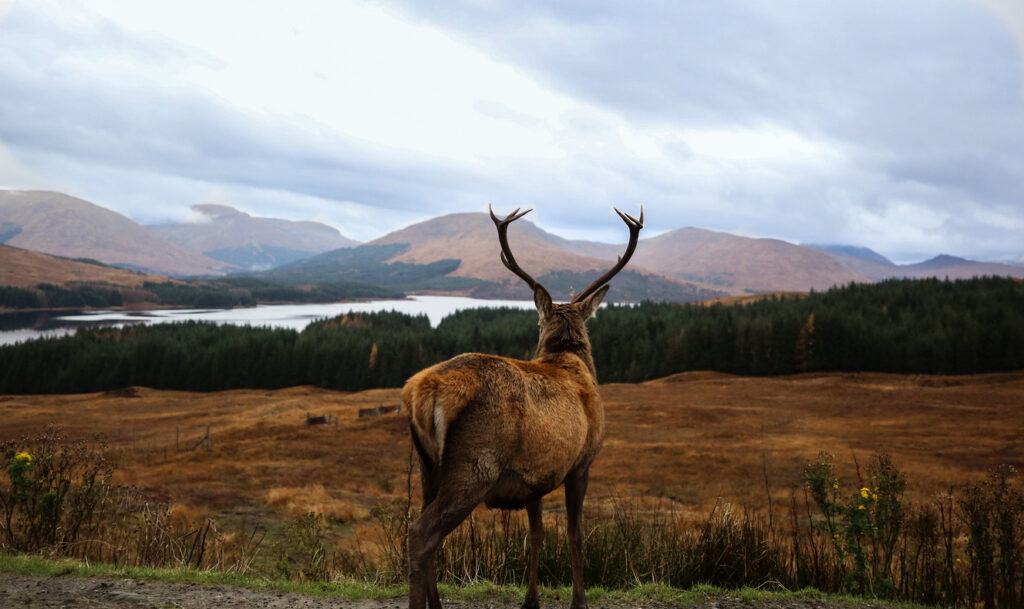Policy Shift in Deer Management for Climate and Nature
23 July 2025Scotland’s wild deer populations have reached historically high levels – estimated at around one million animals, double the 1990 figure. These include red, roe, sika, and fallow deer. Without natural predators and with expanding ranges, deer are increasingly causing ecological and land management issues across the country.
The unchecked growth of deer populations has resulted in:
- Overgrazing of young trees and vegetation.
- Suppression of woodland regeneration and habitat restoration.
- Damage to peatlands, which are critical carbon sinks.
- Increased conflict with agricultural land use (e.g. crop damage, pasture competition).
- Rising incidents of deer-vehicle collisions.
- Poorer animal welfare due to overpopulation (e.g. winter starvation).
The Environmental Need
Deer control is now central to Scotland’s environmental and climate resilience strategy. Healthy woodlands and peatlands are vital for storing carbon, regulating water flows, and supporting biodiversity. However, excessive deer grazing hinders these systems’ recovery and functioning.
- Scotland has committed to restoring degraded peatlands and significantly expanding woodland cover.
- The west coast’s “Atlantic rainforest,” a globally rare and carbon-rich ecosystem, is suffering from deer browsing pressure, with over 40% of sites in poor condition due to grazing.
- Deer can undermine climate benefits by stripping saplings and disturbing soil, thereby releasing stored carbon.
Proactive Management
Deer are a leading obstacle to achieving Scotland’s biodiversity targets, especially the “30×30” commitment (protecting 30% of land for nature by 2030). Deer also challenge rural landowners attempting to establish new forestry or enhance moorland condition.
While fencing has been a traditional mitigation strategy, it’s costly, impractical in many areas, and can displace the problem. The shift in policy is toward reducing deer densities across landscapes to a level that allows natural regeneration without needing constant protection.
Key Policy Development: The Natural Environment (Scotland) Bill
A major legislative change is the introduction of the Natural Environment (Scotland) Bill, which adds a new legal tool for deer control under section 6ZB of the Deer (Scotland) Act 1996. This introduces a new ground for intervention, “nature restoration.”
This new provision allows NatureScot to intervene not only when deer are actively damaging the environment, but also pre-emptively when high deer numbers are likely to undermine the effectiveness of nature restoration efforts.
Key features:
- Scope: Intervention is permitted where deer are likely to hinder any project, action, or natural process that improves the natural environment and contributes to an official environmental, biodiversity or climate target.
- Trigger: Unlike previous provisions, action can now be taken before visible damage occurs, based on the likely impact on planned or ongoing nature restoration.
- Objective: Support habitat restoration and conservation initiatives such as tree planting, peatland restoration, or natural flood management by ensuring deer do not impede their success.
This new ground significantly broadens the criteria under which deer management can be enforced.
Implications for Land Managers
Wider Intervention Powers
NatureScot will now have greater authority to:
- Request or require deer management plans.
- Facilitate control agreements.
- Enforce control schemes where necessary.
This means deer control may be mandated in areas associated with national environmental priorities, not just where immediate damage is visible.
Prevention-Focused Regulation
Landowners could be asked to implement deer management before starting restoration projects such as afforestation or bog rewetting. Deer impacts are being considered in advance of their effect, especially when projects are part of Scotland’s wider environmental plans.
This anticipatory approach aligns with the shift to nature-based solutions for climate and biodiversity crises.
Deer Code Update for Clarity
To ensure clarity, NatureScot will update the statutory Deer Management Code of Practice to explain when and how this new power might be used. This will help landowners plan and understand their responsibilities when engaging in projects tied to nature recovery or climate mitigation.
Benefits and Opportunities
For land and biodiversity:
- Restoring tree and shrub cover improves soil health, reduces runoff, and supports more diverse wildlife.
- Heathlands, wetlands, and peatlands can recover when trampling and overgrazing pressures are reduced.
- Richer vegetation helps ground-nesting birds, pollinators, and woodland species—many of which are in decline.
For climate resilience:
- Improved carbon sequestration from woodlands and peatlands.
- Healthier ecosystems that can better buffer against droughts, floods, and erosion.
- Reduced greenhouse gas emissions from degraded land.
For rural livelihoods:
- Lower crop and fencing damage.
- Enhanced land productivity.
- Support for the venison market and rural employment in sustainable deer management.
- Potential funding and advisory support for land managers engaging with restoration-compatible deer control.
A Balanced Approach
Crucially, this shift is not about eradicating deer but about managing them within sustainable ecological limits. Deer remain a valued part of Scotland’s cultural and natural heritage – integral to rural identity, field sports, and venison supply. Sustainable management ensures that deer coexist with nature restoration goals.
By adjusting deer control practices in response to this new legislative framework, farmers, crofters and estates can play a vital role in supporting national efforts to restore Scotland’s nature and tackle climate change.
Alexander Pirie, SAC Consulting
Sign up to the FAS newsletter
Receive updates on news, events and publications from Scotland’s Farm Advisory Service

